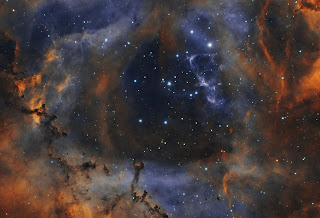This is the second time I imaged this with Canon EF 200mm f/2.8L II USM lens only this time I wanted to try something different from last year's traditional HaRGB image so I went with all narrowband. Rather than doing the normal SHO blend I went to an OHS blend that was described by Antoine & Dalia Grelin (Galactic Hunter) when they did this last year. Their image was fantastic and I wanted to see if I could get a decent image of it as well using their method. I am very pleased with the results and I think this blend allowed for more detail to be visible. The swirly gas stringers scattered throughout this field are breathtaking. I especially like the ones above the B33 and the ones south of M42. There is much more fine detail in each nebula than there is in any of my previous attempts. Most times I would not say zoom in but this one holds up even when zoomed in a bit.
In order to do this I connected a ZWO EFW (1.25") to the camera lens using the low profile ZWO adaptor and attached it to my Sirius Mount located in the astronomy shed. In addition, rather than using the internal lens aperture to control the f-stop, I used stepdown rings in order to obtain the focal ratio of f/4. The reason for doing this is that the star shapes come out much better and it eliminates the eight-sided star spikes from the lenses aperture control.
Dates: 2-14-22, 2-15, 2-18, 2-20, 2-21, 2-25, 2-26, 2-27, 2-28, 3-3, 3-4
http://astroquest1.blogspot.com/
https://www.astrobin.com/users/kurtzepp/collections/
http://youtube.com/c/AstroQuest1
Camera: ZWO ASI1600MM-Pro
Telescope: Canon EF 200mm f/2.8L II USM Lens
Barlow: None
Focal Length: 200mm
Horsehead Nebula, Flame Nebula, and Orion Nebula
Dates: 2-14-22, 2-15, 2-18, 2-20, 2-21, 2-25, 2-26, 2-27, 2-28, 3-3, 3-4Camera: ZWO ASI1600MM-Pro
Telescope: Canon EF 200mm f/2.8L II USM Lens
Barlow: None
Focal Length: 200mm
f/4 with stepdown rings
Focal Reducer: None
Mount: Orion Sirius
Filter Wheel: ZWO EFW 8 x 1.25"
Filter: ZWO Ha, OIII, SII
Focuser: ZWO EAF
Autoguiding: ASI120 Mini attached to a ZWO Mini 30/120mm Guidescope
Exposure: Ha 156 x 180, OIII 94 x 180, SII 141 x 180, Ha 36 x 10, OIII 20 x 10, SII 16 x 10
Gain: 139
Offset 20
Sensor Temp: -20 C
Processing: NINA, PixInsight, Photoshop, Topaz DeNoiseAI, StarXTerminator.
https://www.instagram.com/astroquest1/
http://astroquest1.blogspot.com/
https://www.astrobin.com/users/kurtzepp/collections/
http://youtube.com/c/AstroQuest1
Focal Reducer: None
Mount: Orion Sirius
Filter Wheel: ZWO EFW 8 x 1.25"
Filter: ZWO Ha, OIII, SII
Focuser: ZWO EAF
Autoguiding: ASI120 Mini attached to a ZWO Mini 30/120mm Guidescope
Exposure: Ha 156 x 180, OIII 94 x 180, SII 141 x 180, Ha 36 x 10, OIII 20 x 10, SII 16 x 10
Gain: 139
Offset 20
Sensor Temp: -20 C
Processing: NINA, PixInsight, Photoshop, Topaz DeNoiseAI, StarXTerminator.
https://www.instagram.com/astroquest1/
http://astroquest1.blogspot.com/
https://www.astrobin.com/users/kurtzepp/collections/
http://youtube.com/c/AstroQuest1





